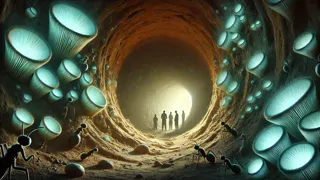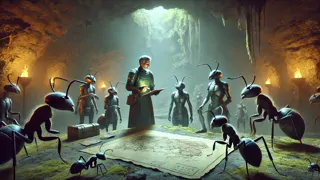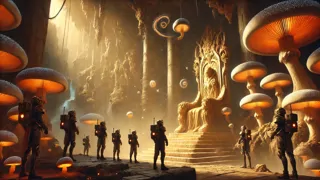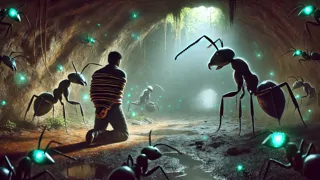Introduction
Mara Jacobs jolted awake in total darkness, the weight of centuries of soil pressing hard against her lungs. At first she thought it was a dream—until she realized her arms were bound by slender, chitinous straps and her breathing echoed among unseen walls. The earth around her pulsed, alive with a distant rhythm: the march of mandibles and the click of insect legs. Panic flared, but Mara forced herself to breathe evenly. She had trained for extreme fieldwork, but nothing prepared her for this living nightmare.
Gradually, her eyes adjusted to a dim, bioluminescent glow. Tiny fungal clusters sprouted along the damp tunnel walls, illuminating rows of towering columns carved into the clay. Above her, a vaulted ceiling of root veins seemed to pulse like a heart. She realized in horror that she was deep beneath the surface in a vast network of ant-made corridors—an empire hidden from humanity for millennia.
Dragged by a legion of tenebrous soldiers, Mara faced her captors: ant people, six feet tall, their exoskeletons gleaming obsidian with segmented armor plates. Their compound eyes reflected cold analysis as they herded her into a cavernous chamber. In its center stood a throne hewn from gleaming mandibles and polished stone. On it sat a colossal queen with a crown of smoldering fungal torches. Fear and fascination warred within Mara’s mind: she was both prey and pioneer witnessing an entire civilization.
As the queen’s multi-jointed antennae twitched, Mara realized that survival meant more than escape—it meant learning the rules of this hive culture. Beneath the terror, a plan began to form. She would exploit the colony’s hidden fractures, rally the outcasts, and spark a rebellion. For buried alive among ants, she would become their liberation—or their doom.
Awakening in the Labyrinth
Mara’s cell was a damp niche carved into the stone-crusted walls of the central tunnels. She measured her surroundings with cautious, precise movements, testing the chitin straps binding her wrists. The guards had left her with a small bowl of nutrient paste—thick, sweet, and unsettlingly alive with protein strands. She nibbled it carefully, every bite a reminder that she was now part of the colony’s food chain.

Over the next several cycles of the dim luminescence, Mara observed the traffic of the hive. Workers scurried by with shards of mineral rock, soldier ants patrolled with lethal precision, and brood caretakers tended to clusters of translucent eggs. She counted patrol patterns and listened to the queen’s distant rumblings through the tunnels. Each step they took vibrated across the walls, carrying messages of rank and purpose she longed to decode.
By mimicking the antenna flicks of a frightened worker, Mara managed to slip out of her niche at last. She stole through side passages, her heart hammering. She found a stockpile of discarded exoskeleton fragments—bones of her would-be jailers. There, she tucked away a slender shard sharp enough to be a knife. Next, she encountered a sub-colony of smaller ant folk shunned for their deformed mandibles. They eyed Mara with equal parts fear and hope; both invaders of their society. By offering to share her limited supplies—scraps of fungus and nutrient paste—she earned their trust.
Late in their subterranean night, they guided Mara to a hidden chamber bustling with dissenters: injured soldiers, orphaned caretakers, and broken workers. Their whispered stories revealed the cracks in the queen’s iron rule—factions pitted against one another over scarce resources and tunnel expansion projects. Here, Mara saw the spark she needed: discord. If she could fan these embers, rally the outcasts, and unite their grievances, the hive’s unstoppable machinery might grind to a halt.
From that moment, Mara became more than a prisoner; she became an agent of change. She taught the downtrodden tactics she gleaned from military documentaries: diversionary feints, synchronized strikes, and sabotage of supply lines. In exchange, they showed her secret passages and nutrient caches. Every stolen morsel fueled her brain and her cause. When the queen’s nightly proclamations echoed through the stone halls, Mara realized she had ignited a silent fire—one that threatened to consume the entire ant empire from within.
Forging Alliances Under the Queen’s Gaze
Word of Mara’s leadership began to spread through the colony’s lower levels. At first, only the malformed and the wounded rallied to her cause. But then, on a damp corridor just beyond the brood chamber, a veteran soldier with scarred antennae approached Mara under cover of a ventilation shaft. He introduced himself as Sirael, once the queen’s most trusted lieutenant. He had seen too many young workers crushed under brutal quotas and countless transports lost in expansion tunnels.

With Sirael’s insider knowledge, Mara’s network grew rapidly. They sabotaged food shipments destined for the queen’s elite guard, redirected worker streams to create crippling bottlenecks, and spread whispered rumors of the queen’s vulnerability among the common folk. Each act of defiance was small—shifting the flow of nutrient paste, misdirecting patrols—but collectively it began to undermine the colony’s cohesion.
One night, deep in the underbelly’s Archive Hollows, Mara and her council discovered stolen relics: maps of the entire ant capital, ancient scripts describing former queens overthrown for tyranny. The crumbling tablets contained tactics for staging palace coups—how to isolate the monarch, how to disarm the royal guard, and how to sway public opinion against despotism. Mara pored over these texts by the dim glow of bioluminescent moss, her mind racing with possibilities.
As dawn approached, the rebels convened in the Forgotten Junction, a crossroads of disused tunnels. Mara climbed onto a rough-hewn slab, her voice carrying across gathered ants. She spoke of freedom, of ceasing endless expansion, of unity with surface dwellers who could repair the land above. Many listeners wavered; centuries of conditioning made them fear reprisal. But when Sirael and two dozen soldier defectors reaffirmed their loyalty to Mara’s vision, the tide turned. A chorus of clicks rose, echoing against the earthen walls—an insect call to arms.
Over the next cycle, Mara orchestrated a three-pronged operation: workers would disable the nutrient vats that fed the queen’s guard, soldier rebels would seize control of the royal tunnels, and caretaker allies would flood the palace with blistering spores to disorient the monarch. Every move was timed to the colony’s five-minute structural vibrations, ensuring that the queen’s loyalists would be overwhelmed before they could mount an effective defense. Mara felt a fierce thrill: for the first time since her abduction, she held the fate of this subterranean world in her own hands.
Revolt in the Queen’s Court
The day of the coup broke with a shudder as dozens of sappers collapsed a support pillar near the royal elevator, sending rock and soil crashing into the palace antechamber. Alarm bells—scarab-like clicking devices—blared through the citadel. Commander Neryx, the queen’s fiercest captain, rallied her guard, but they found vault doors sealed, supply lines cut, and their ammunition stores repurposed for the insurrection.

Mara led the final incursion, a slender blade of metal pressed to her side. With soldier rebels at her back, she stormed the throne room where the queen sat enthroned on a throne of mandibles. The queen’s massive mandibles snapped in fury as spores hung heavy in the air, casting panic among loyalists. Mara strode forward, her voice echoing: “Your reign ends now. This colony deserves justice, not endless conquest.”
A furious battle erupted. Rebel and royal soldier clashed in swirling clouds of spore and dust. Mara dodged a lash of chitin, slashed at a guard’s joint, and felt adrenaline fuse with purpose. When Commander Neryx fell, the queen reeled in shock. In that moment, Mara confronted her: a towering figure draped in fungal torches and armored plates. The queen’s antennae lashed, demanding submission.
But the colony had already decided. A roar of clicks rose from the gathered workers and caretakers in the galleries. They jeered at the queen’s pleas, remembering endless tunneling quotas and the suffering of their kin. With a final, echoing click, the queen surrendered her crown and abdicated. Sirael stepped forward to place a ring of fungal torches at Mara’s feet, symbolizing her as Protector of the Colony rather than tyrant.
In the aftermath, tunnels once dedicated to expansion were repurposed for farming mushrooms and caring for brood. Surface access shafts were opened on Mara’s counsel, allowing sunlight and fresh air to seep into the depths. Human scientists on the surface rejoiced as long-lost colleagues appeared, coated in earthen dust but triumphant. Mara emerged as both hero and ambassador, bridging two worlds once locked in fear and misunderstanding. The ant people, inspired by her courage, vowed to live in harmony with the world above, their revolt proving that even in the darkest earth, one spark of hope can light an empire-wide revolution.
Conclusion
The subterranean echo of victory lingered long after the dust settled in the ant queen’s court. Mara Jacobs stood at the threshold between two worlds—the heaving corridors of the newly freed colony at her back, and the open sky of her homeland beyond the surface shaft before her. She traced the rough-hewn walls with a reverent hand, remembering every sacrifice and every bond forged in darkness. Where once the ant people had built an empire of relentless expansion, they now cultivated harmony, their tunnels transformed into flourishing farms and communal halls.
Mara’s heart swelled with the knowledge that no matter how oppressed a people—or a person—might feel, hope could sprout in the most unlikely earth. In the months that followed, she established a council representing both humans and ant folk, dedicated to sharing knowledge and safeguarding ecosystems above and below ground. On the surface, the world celebrated the first ambassadors from an insect civilization, curious and inspired by their tales. In the depths, children played beneath fungus canopies, free at last from drudgery, learning of unity and justice from their protector.
The story of the human prisoner who toppled a queen became legend, passed in whispered clicks through ant tunnels and in earnest lectures across human universities. Mara Jacobs continued her research, studying the delicate balance of ecosystems with fresh insight. She never forgot the moment she realized that courage, when combined with compassion, could shift the tides of any empire. And deep beneath the earth, a new era had dawned—one where two races, once captive and captor, now walked side by side toward a brighter future.



















